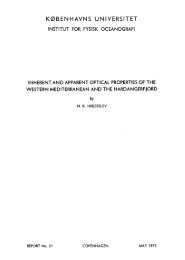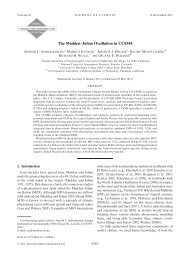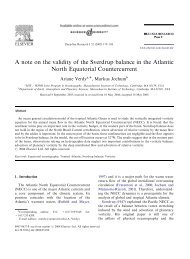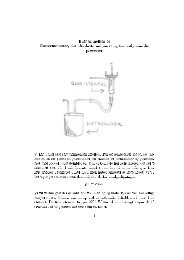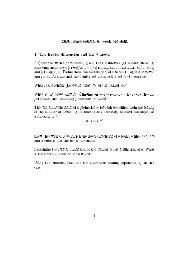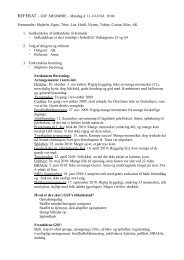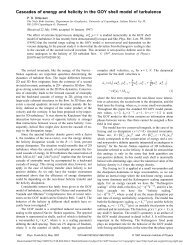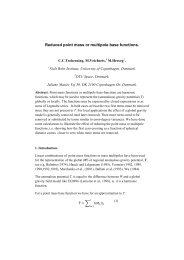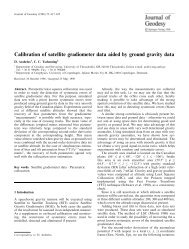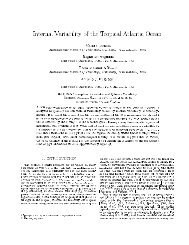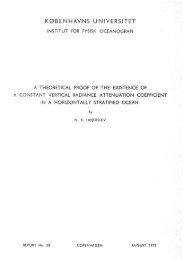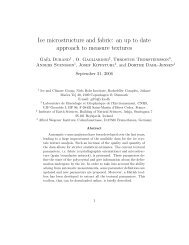Commission 1 - Reference Frames
Commission 1 - Reference Frames
Commission 1 - Reference Frames
You also want an ePaper? Increase the reach of your titles
YUMPU automatically turns print PDFs into web optimized ePapers that Google loves.
<strong>Commission</strong> 1 - <strong>Reference</strong> <strong>Frames</strong>web: iag.dgfi.badw.dePresident: Hermann Drewes (Germany)Vice President: C.K. Shum (USA)Terms of <strong>Reference</strong>Geodetic reference frames are the basis for threedimensional,time dependent positioning in global, regionaland national networks, cadastre, engineering, precisenavigation, geo-information, geodynamics, sea levelstudies, and other geosciences. They are necessary toconsistently estimate unknown parameters using geodeticobservations, e.g., station coordinates, crustal motions,Earth orientation parameters. <strong>Commission</strong> 1 is focused onthe scientific research associated with the definition andrealization of global and regional reference frames as wellas the development of analysis and processing methods forrelevant geodetic observations. Different terrestrial andspace-borne measuring techniques shall be investigatedwith respect to their strengths and weaknesses forparameter estimation, their respective precision, accuracyand reliability. The proper use of these techniques forgeodetic research shall be coordinated and methods for thecombination of heterogeneous measurements shall bestudied and disseminated. The basis for globally unifiedreference frames for three-dimensional positioning andmonitoring of motions, horizontal and vertical, over land,water and ice, shall be provided and disseminated amongthe scientific and users community as well as theappropriate IAG Services.<strong>Commission</strong> 1 is identical with the Sub-commission B2 ofthe Scientific <strong>Commission</strong> B of the ICSU Committee onSpace Research (COSPAR).ObjectivesThe principal objective of the scientific work of<strong>Commission</strong> 1 is the basic research on:- Definition, establishment, maintenance, andimprovement of geodetic reference frames.- Advanced development of terrestrial and spaceobservation techniques for this purpose.- Analysis and processing methods for parameterestimation related to reference frames.- Theory and coordination of astrometric observations forreference frame purposes.Additional objectives of the <strong>Commission</strong> are theinternational collaboration:- For the definition and deployment of networks ofobservatories.- With related scientific organizations, institutions,agencies, and IAG Services.StructureSub-<strong>Commission</strong>s:SC1.1:SC1.2:SC1.3:Coordination of Space TechniquesPresident: M. Rothacher (Germany)Global <strong>Reference</strong> <strong>Frames</strong>President: Claude Boucher (France)Regional <strong>Reference</strong> <strong>Frames</strong>President: Zuheir Altamimi (France)SC1.3 a: EuropeChair: Joao Torres (Portugal)SC1.3 b: South and Central AmericaChair: Luiz Paulo Fortes (Brazil)SC1.3 c: North AmericaChair: Michael Craymer (Canada)SC1.3 d: AfricaChair: R. Wonnacott (South Africa)SC1.3 e: Asia-PacificChair: John Manning (Australia)SC1.3 f: AntarcticaChair: Reinhard Dietrich (Germany)SC1.4:Interaction of Celestial and Terrestrial<strong>Reference</strong> <strong>Frames</strong>President: Shen Yuan Zhu (Germany)
Inter-<strong>Commission</strong> Projects:IC-P1.1: Satellite Altimetry(Joint with <strong>Commission</strong>s 2 and 3)Chair: Wolfgang Bosch (Germany)IC-P1.2: Vertical <strong>Reference</strong> <strong>Frames</strong>(Joint with <strong>Commission</strong> 2)Chair: Johannes Ihde (Germany)Inter-<strong>Commission</strong> Study Groups:IC-SG1.1: Ionosphere Modelling and Analysis(Joint with <strong>Commission</strong> 4 and COSPAR)Chair: Claudio Brunini (Argentina)IC-SG1.2: Use of GNSS for <strong>Reference</strong> <strong>Frames</strong>(Joint with <strong>Commission</strong> 4 and IGS)Chair: Robert Weber (Austria)Inter-<strong>Commission</strong> Working GroupsRotation and <strong>Reference</strong> Systems Service (IERS), itsProducts Centres and Combination Research Centres andworking groups. Emphasis will be laid on the assistance toindividual countries in establishing their national referenceframes.Steering CommitteePresident: Hermann Drewes (Germany)Vice President: C.K. Shum (USA)President SC1.1: Markus Rothacher (Germany)President SC1.2: Claude Boucher (France)President SC1.3: Zuheir Altamimi (France)President SC1.4: Shen Yuan Zhu (Germany)Representatives of IERS/IDS/IGS/ILRS/IVS:Werner Gurtner (Switzerland)Chopo Ma (USA)John Ries (USA)Members at large:John Manning (Australia)Richard Wonnacott (South Africa)IC-WG 1: Quality Measures, Quality Control andQuality Improvement(Joint with ICCT and <strong>Commission</strong> 2)(Description: See ICCT)Chair: H. Kutterer (Germany)IC-WG2: Integrated theory for Crustal Deformation(Joint with ICCT and <strong>Commission</strong> 3)(Description: See ICCT)Chair: K. Heki (Japan)IC-WG3: Satellite Gravity Theory(Joint with ICCT and <strong>Commission</strong> 2 )(Description: See ICCT)Chair: N. Sneeuw (Canada)Program of ActivitiesThe <strong>Commission</strong> encourages, initiates and supports basicresearch in the field of geodetic reference frames,exchanges the experiences with the relevant IAG servicesand COSPAR entities, and disseminates the results. Itassists in the coordination of geodetic techniques relevantfor reference frames and elaborates concrete methods toimprove its quality and reliability. Regular exchange ofinformation via internet by e-mails and the <strong>Commission</strong>’shomepage shall enhance the contact between variousgroups engaged in reference frames research. An annualbulletin is planned for publishing the results. A closecooperation will be established with the International Earth
Sub-<strong>Commission</strong>SC 1.1 - Coordination of Space TechniquesPresident: Markus Rothacher (Germany)Terms of <strong>Reference</strong>The space geodetic observation techniques, including VeryLong Baseline Interferometry (VLBI), Satellite and LunarLaser Ranging (SLR/LLR), Global Navigation SatelliteSystems (GNSS) such as GPS, GLONASS, and in futureGALILEO, the French DORIS, as well as altimetry,InSAR, and the gravity missions, contribute significantly tothe knowledge about and the understanding of the threemajor pillars of geodesy: the Earth's geometry (pointcoordinates and deformation), Earth orientation androtation, and the gravity field as well as its time variations.These three fields interact in various ways and they allcontribute to the description of processes in the EarthSystem. Each of the space geodetic techniques contributesin a different and unique way to these three pillars and,therefore, their contributions should be combined into aconsistent Integrated Global Geodetic Observing System(IGGOS), the project of the IAG.Sub-<strong>Commission</strong> 1.1 coordinates efforts that are commonto more than one space geodetic technique, such as models,standards and formats. It shall study combination methodsand approaches concerning links between techniques colocatedat fundamental sites, links between techniques colocatedonboard satellites, common modelling andparameterisation standards, and perform analyses from thecombination of a single parameter type up to a rigorouscombination on the normal equation (or variancecovariancematrices) and even the observation level. Thelist of interesting parameters includes site coordinates (e.g.time series of combined solutions), Earth orientationparameters, satellite orbits (combined orbits from SLR,GPS, DORIS, altimetry), atmospheric refraction(troposphere and ionosphere), gravity field coefficients,geocenter coordinates, etc. One important goal of SC1.1will be the development of a much better understanding ofthe interactions between the parameters describinggeometry, Earth rotation, and the gravity field as well as thestudy of methods to validate the combination results, e.g.,by comparing them with independent geophysicalinformation.To the extent possible SC1.1 should also encourageresearch groups to develop new observation techniquesconnecting or complementing the existing set ofmeasurements.Sub-<strong>Commission</strong> 1.1 has the task to coordinate theactivities in the field of the space geodetic techniques inclose cooperation with all the IAG Services, especially withthe IERS and its Working Group on Combination, and withCOSPAR.ObjectivesThe principal objectives of the scientific work of Sub-<strong>Commission</strong> 1.1 are the following:- Study systematic effects of or between space geodetictechniques.- Develop common modelling standards and processingstrategies.- Comparison and combination of orbits derived fromdifferent space geodetic techniques together with theIGS LEO Working Group.- Explore and develop innovative combination aspectssuch as, e.g., GPS and VLBI measurements based onthe same high-accuracy clock, VLBI observations toGNSS satellites, combination of atmosphericinformation (troposphere and ionosphere) of more thanone technique, etc.- Establish methods to validate the combination results(e.g., with global geophysical fluids data).- Explore, theoretically and practically, the interactionsbetween the gravity field parameters, EOPs, andreference frames (site coordinates and velocities),improve the consistency between these parametergroups, and assess, how a correct combination could beperformed.- Study combination aspects of GPS and InSAR.Additional objectives of Sub-<strong>Commission</strong> 1.1 are:- Promotion of international scientific cooperation.- Coordination of common efforts of the space geodetictechniques concerning standards and formats (togetherwith the IERS).- Organization of workshops and sessions at meetings topromote research.- Establish bridges and common activities between SC1.1and the IAG Services.Links to ServicesSub-<strong>Commission</strong> 1.1 will establish close links to therelevant services for reference frames, namely InternationalEarth Rotation and <strong>Reference</strong> Systems Service (IERS),International GPS Service (IGS), International LaserRanging Service (ILRS), International VLBI Service forGeodesy and Astrometry (IVS), and International DORISService (IDS).
MembershipPresident: Markus Rothacher (Germany)Working Groups:WG 1.1.1: Comparison and combination ofprecise orbits derived from different space geodetictechniques (joint with the IGS LEO WG)This working group is taking over the role of the formerCSTG Sub-commission on Precise Orbit Determination(POD) of Low Earth Orbiting (LEO) Satellites. It will workclosely together with the IGS LEO Working Group, butwill have a broader research field not focussing on GPS, buton the interplay between different tracking techniques. Themain topics of the WG will be:The task of this working group shall be the comparison andthe combination of information about the atmospherederived from different space geodetic techniques such asGPS, VLBI, InSAR, altimetry, etc. A very closecooperation with the IAG services, especially the IGS andthe IVS are essential. Major research topics are:- Investigate differences between tropospheric delayparameters estimated by different techniques; assesssystematic biases between techniques and the accuracyof each individual technique; consider ways to combineand validate the information of different techniques.- Study the accuracy of global or regional ionospheremaps or simple delays derived from differenttechniques; assess systematic biases; compare, combine,and validate results.- Comparison and combination of satellite orbits derivedfrom various tracking techniques, including SLR,DORIS, GPS, altimetry, K-band links, CCD, andpossible future observation techniques. Satellite orbitsranging from LEOs up to geostationary satellites(GEOs) should be considered.- Assessment of systematic errors between different orbittypes and observation techniques.- Study of improved force models and POD strategiesbased on the combination of techniques.WG 1.1.2: Interaction and consistency betweenterrestrial reference frame, Earth rotation, and gravityfield(joint with <strong>Commission</strong> 2, <strong>Commission</strong> 3, and IGGOS)This working group has to be a joint working grouptogether with <strong>Commission</strong> 2, <strong>Commission</strong> 3, and IGGOS.Its main research topics are:- Study the theoretical and practicalinteractions/relationships between parameters andmodels describing the Terrestrial <strong>Reference</strong> Frame(TRF), Earth rotation, and the gravity field (e.g., lowdegree harmonics of the gravity field, Love numbers...).- Assess and study the consistency between products ofthese three fields.- Investigate methods and techniques to combinegeometry, Earth rotation, and gravity field parameters(e.g., by including LEO satellites into global solutions).WG 1.1.3: Comparison and combination ofatmospheric information derived from different spacegeodetic techniques(Joint with IGS Troposphere WG, IGS Ionosphere WG,and IVS)
Sub-<strong>Commission</strong>SC 1.2 - Global <strong>Reference</strong> <strong>Frames</strong>Terms of <strong>Reference</strong>President: Claude Boucher (France)Sub-<strong>Commission</strong> 1.2 is engaged in scientific research andpractical aspects of the global reference frames. Itinvestigates the requirements for the definition andrealization of the terrestrial reference frame, addressesfundamental issues of multi-technique global geodeticobservatories (local ties, site effects…) and studies methodsand approaches for the combined processing ofheterogeneous observation data. The work will be done inclose cooperation with the International Earth Rotation and<strong>Reference</strong> Systems Service (IERS), in particular with theITRS Product Centre and the IERS Combination ResearchCentres (CRC), the other relevant IAG services (IGS, ILRS,IVS, IDS), and the IAG Project “Integrated GlobalGeodetic Observing System (IGGOS)”. Theoretical aspects(e.g., quality measures, relativistic modelling) will beinvestigated in cooperation with the Inter-<strong>Commission</strong>Committee on Theory.ObjectivesThe following research topics will form the fundamentalobjectives during the next period:- Definition of the global terrestrial reference frame(origin, scale and orientation, time evolution, standards,conventions, models);- Fundamentals of the realization of the global terrestrialreference frame (e.g., co-location problems: local ties;datum problems: coordinates origin, geo-centre; timeevolution: linear and non-linear velocities, time seriesapproach; long-term consistency with EOPs and ICRF);- Analysis of strengths, weaknesses and systematicdifferences (biases) of individual techniques (VLBI,SLR, GPS, DORIS) and their contribution to specificTRF parameters;- Combination methodology of individual techniques’solutions and analysis of the underlying models,parameters datum definitions etc.;- Definition of common standards and models for alltechniques.- Practical implementation of the concept of GlobalGeodetic Observatories.- Propagation of the ITRS/ITRF to national andinternational organizations.Program of ActivitiesA Web site and mailing system will be established for abetter exchange of information with regard to thementioned objectives and with the respective componentsof the IERS, other services and the scientific community.The necessity of the use of the ITRF as the reference framesfor any kind of precise global positioning using spacetechniques shall be propagated among geodesy, othergeosciences and society in general. It will also investigatethe opportunity to formally adopt ITRF as primaryrealization of a common Earth fixed, Earth centred systemin all applications: geodesy, surveying, mapping,navigation, geomatics etc. and clarify its relation withsystems such as WGS84. Adequate activities have to bedeveloped.Links to ServicesSub-<strong>Commission</strong> 1.2 will closely be linked to the relevantservices, in particular to the International Earth Rotationand <strong>Reference</strong> Systems Service (IERS), but also to theInternational GPS Service (IGS), International LaserRanging Service (ILRS), International VLBI Service forGeodesy and Astrometry (IVS), and International DORISService (IDS).MembershipPresident: Claude Boucher (France)Working GroupsIC WG 1.2.1: Datum Definition of Global Terrestrial<strong>Reference</strong> <strong>Frames</strong>(Joint with IERS and ICCT)Chair: Geoffrey Blewitt (USA)Terms of <strong>Reference</strong>The Working Group is to deliver recommendations, inparticular to the IERS, on possible datum definitions ofGlobal Terrestrial <strong>Reference</strong> <strong>Frames</strong> (GTRFs) with the goalof improving the relevance, stability, quality, andunderstanding of GTRFs for various potential user groups.The principal objectives are:- To assist the IERS Analysis Coordinator and ITRSCombination Centres by providing recommendations ondatum conventions for future realizations of ITRF.- To assist the ICCT in drafting conventional definitionsof technical terms that refer to the various possiblecomponents of GTRFs.- To identify the needs of potential user groups of GTRFsand address issues of datum definition that might benefitthose groups.
- To compile a short summary document that referencesall recent published journal articles (not just those of theWG) relevant to datum definition of GTRFs, including asummary of the findings, conclusions, and significanceof each paper, and to keep such a document updated as areference document to assist research and informeddiscussion.Program of Activities- To study the different types of possible reference systemdefinitions that might be important for different researchfields (sea level, geoid, deformation, Earthorientation...) and for what measurements they areimportant.- To assess the uncertainties and quality of the variousrealizations, how they are affected by geophysicalprocesses, and how the effect of these processes can bemodelled in time and space to allow a refinedrealization of the frames.- To assess how a stable and consistent reference framecan be realized over decades with the limited number ofstations and observations.- To study datum definition in a relativistic framework, inparticular in view of the CRS/TRS transformation.- To study the impact of IAU non-rotating origin on TRS,if any.WG 1.2.3: Integrated Theory for CrustalDeformation and <strong>Reference</strong> <strong>Frames</strong>(Joint with <strong>Commission</strong> 3 and ICCT)Chair: Kosuke Heki (Japan)Terms of <strong>Reference</strong>The effect of short-term crustal deformations, e.g., due toloading effects, on the reference frame parameters (heights,velocities, etc.) is important for the definition andrealization of global reference frames: To which standardatmospheric pressure refer the coordinates (in particular theheights)? Have non-linear velocities (e.g., periodical) to beestimated?(Detailed program description see in Inter-<strong>Commission</strong>Committee on Theory)WG 1.2.2:Global Geodetic Observatories(Joint with IERS)Chair: Jim Long (USA)Terms of <strong>Reference</strong>Global geodetic observatories play a fundamental role inthe installation of the global reference frame. They establishthe connection between different techniques and providethe basis for the realization of the unique datum.Program of ActivitiesThe reliability of global geodetic observatories, inparticular of the local ties between different techniques’observing instruments, shall be investigated in view of thefundamental importance for the inter-technique analysisand combination. The co-location strategies will beinvestigated, as well as all aspect of local site surveymeasurement, processing and reporting. The group will inparticular provide any guideline to be implemented in theIERS activities, as well as Technique Services.
Sub-<strong>Commission</strong>SC 1.3 - Regional <strong>Reference</strong> <strong>Frames</strong>Terms of <strong>Reference</strong>President: Zuheir Altamimi (France)Sub-<strong>Commission</strong> 1.3 is concerned with definitions andrealizations of regional reference frames and theirconnection to (and the densification of) the globalInternational Terrestrial <strong>Reference</strong> Frame (ITRF). It offersa home for service-like activities addressing theoretical andtechnical key common issues of interest to regionalorganisations.ObjectivesIn addition to specific objectives of each regional subcommission,the main objectives of SC1.3 as a whole are:- Develop specifications for the definition and realizationof regional reference frames, including vertical datums,with full interaction with the Inter-<strong>Commission</strong> ProjectICP 1.2 on Vertical <strong>Reference</strong> <strong>Frames</strong>.- Develop and promote operation of GPS permanentstations, in connection with IGS whenever appropriate,to be the basis for the long-term maintenance ofregional reference frames.- Coordinate activities of the regional sub-commissionsfocusing on exchange and share of competences andresults.- Encourage and stimulate the emerging development ofthe AFREF project with close cooperation with IGS.- Encourage and assist, within each regional subcommission,countries to re-define and modernize theirnational geodetic systems, compatible with the ITRF.Links to ServicesThe regional reference frame activities are tied into thevarious IAG services through provision of data fromindividual sites to:- International Earth Rotation and <strong>Reference</strong> SystemsService (IERS)- International GPS Service (IGS)- International Laser Ranging Service (ILRS)- International VLBI Service for Geodesy and Astrometry(IVS)- International DORIS Service (IDS)MembershipPresident: Zuheir Altamimi (France)SC1.3a Chair: João Agria Torres (Portugal)SC1.3b Chair: Luiz Paulo Fortes (Brazil)SC1.3c Co-Chairs: Michael Craymer (Canada), RichardSnay (USA)SC1.3d Chair: Richard Wonnacott (South Africa)SC1.3e Chair: John Manning (Australia)SC1.3f Chair: Reinhard Dietrich (Germany)Working GroupsWG 1.3.1:Terms of <strong>Reference</strong>Inter-regional Technical Working GroupThe main task of this WG is to develop harmonized andpossibly common specifications for the regional referenceframes implementation and ITRF densification.Program of Activities- Organize inter-regional workshop(s) addressingactivities, results and key issues of common interest tothe regional sub-commissions.- Develop analysis strategies and compare methods forthe implementation of the regional reference framesand their expression in the ITRF, with full interactionwith the IGS.- Consider establishing regional dense velocity fieldsfor, primarily, the long-term maintenance of theregional reference frames.- Contribute at regional levels to the improvement oflocal surveys in the collocation sites, with fullcooperation with the Sub-commission 1.2 Global<strong>Reference</strong> <strong>Frames</strong>.
Sub-<strong>Commission</strong>SC 1.3a - Europe (EUREF)Chair: Joao Torres (Portugal)Representatives from European IAG member countriesTechnical Working Group (TWG) members elected by theplenaryMembers in charge of special projects and ex-officiomembers.Terms of <strong>Reference</strong>EUREF, the Regional <strong>Reference</strong> Frame Sub-commissionfor Europe, deals with the definition, realization andmaintenance of the European <strong>Reference</strong> Frame, focusing onboth the spatial and the vertical components, in closecooperation with the pertinent IAG components (Services,<strong>Commission</strong>s, and Inter-commission projects) andEuroGeographics, the consortium of the National MappingAgencies (NMA) in Europe.Program of Activities- Continue to develop the EUREF Permanent Network(EPN) in close cooperation with IGS, for themaintenance of the European <strong>Reference</strong> Frame, as acontribution to the ITRF and as infrastructure to supportother relevant projects, namely the European initiativesrelated with GALILEO.- Extend the Unified European Levelling Network(UELN) and prepare it to be computed under ageokinematic approach.- Implement the project European Combined GeodeticNetwork (ECGN) and investigate the discrepanciesalready identified in the combination of the EUVN(European United Vertical Network) results and thegravimetric geoid (project EUVN_DA), in closecooperation with IAG <strong>Commission</strong> 2.- Establish a dense velocity field model in Europe for thelong-term maintenance of the European referenceframe.- Consider the contribution to the IAG Project IGGOS(Integrated Global Geodetic Observing System) usingthe installed infra-structures managed by the EUREFmembers.- Promote the adoption of the reference systems definedby EUREF (ETRS89-European Terrestrial <strong>Reference</strong>System and EVRS2000-European Vertical <strong>Reference</strong>System) in the European countries and European-wideorganizations involved in geo-referencing activities.- Organize annual symposia addressing activities carriedout at national and European-wide level related with theglobal work and objectives of EUREF.MembershipChair: Joao Torres (Portugal)Secretary: Helmut Hornik (Germany)
Sub-<strong>Commission</strong>SC 1.3b - South and Central America(SIRGAS)Terms of referenceChair: Luiz Paulo Fortes (Brazil)Sub-commission 1.3b (South and Central America)encompasses the activities developed by the “Geocentric<strong>Reference</strong> System for the Americas” project (SIRGAS). Assuch, it is concerned with the definition and realization of aunified reference frame for South and Central America,consistent with ITRF, besides promoting the definition andestablishment of a unique vertical reference system in thisregion.- To contribute to the determination of a unified quasigeoidfor the regionMembershipChair: Luiz Paulo Fortes (Brazil)Vice-Chair: Eduardo Lauría (Argentina)Chair WG1.3b.1: the SIRGAS WG1 PresidentChair WG1.3b.2: the SIRGAS WG2 PresidentChair WG1.3b.3: Laura Sánchez (Colombia)Working GroupsWG 1.3b.1: Geocentric <strong>Reference</strong> FrameWG 1.3b.2: Geocentric DatumWG 1.3b.3: Vertical DatumObjectivesThe aims and objectives of the Sub-commission 1.3b are:- To define, realize and maintain a geocentric referencesystem for South and Central America consistent withITRF;- To establish a geocentric datum, promoting theconnection of the national geodetic networks to it;- To promote the definition and establishment of a uniquevertical reference system for this region;- To facilitate the connection of pre-existing networks;- To promote and coordinate the efforts of each countryto achieve the defined objectives.Program of ActivitiesThe SIRGAS 2000 GPS campaign was carried out fromMay 10 to 19, 2000, in order to support the computation ofa velocity field for South America and the activities ofSIRGAS WG3. In total, 184 stations were established in theAmericas, whose coordinates were computed and areavailable on the project website(http://www.ibge.gov.br/sirgas). The next project activitiesare:- To conclude the determination of the velocity field forSouth America, based on independent computationsusing collocation and finite elements- To carry out spirit leveling of the SIRGAS 2000 stations- To connect the classical vertical networks betweenneighboring countries- To compute geopotential numbers for stations of thenational vertical networks- To collaborate with the determination of the sea surfacetopography
Sub-<strong>Commission</strong>SC 1.3c - North America (NAREF)Chair: Michael Craymer (Canada)Co-chair: Richard Snay (USA)Terms of <strong>Reference</strong>To provide international focus and cooperation for issuesinvolving the horizontal, vertical, and three-dimensionalgeodetic control networks of North America, includingCentral America, the Caribbean and Greenland (Denmark).For more information, see www.naref.org.ObjectivesIn collaboration with the IAG community, its serviceorganisations and the national geodetic organizations ofNorth America, the aims and objectives of this regionalsub-commission are to provide international focus andcooperation for issues involving the horizontal, vertical andthree dimensional geodetic control networks of NorthAmerica. Some of these issues include:- Densification of the ITRF reference frame in NorthAmerica and the promotion of its use;- Maintenance and future evolution of vertical datums(ellipsoidal and orthometric), including the NorthAmerican Vertical Datum of 1888 (NAVD88) and theInternational Great Lakes Datum (IGLD);- Collocation of different measurement techniques, suchas GPS, VLBI, SLR, DORIS, tide gauges, etc.;- Effects of crustal motion, including post-glacial reboundand tectonic motions along, e.g., the western coast ofNorth America and in the Caribbean;- Standards for the accuracy of geodetic positions;- Outreach to the general public through focusedsymposia, articles, workshops and lectures, andtechnology transfer to other groups.MembershipChair: Michael Craymer (Canada)Co-chair: Richard Snay (USA)Members: Per Knudsen (Denmark), TBD (Mexico), TBD(Caribbean)Working GroupsWG 1.3c.1: North American <strong>Reference</strong> Frame(NAREF)Chair: Michael CraymerMembers: B. Donahue (Canada), H. Dragert (Canada), C.Huot (Canada), M. Piraszewski (Canada), F.B. Madsen(Denmark), M. Cline (USA), B. Dillinger (USA), P. Fang(USA). R. Snay (USA), R. Ferland (Canada, IGSRepresentative)Program of ActivityTo densify the ITRF reference frame in the North Americanregion by organizing the computation of weekly coordinatesolutions and associated accuracy information forcontinuously operating GPS stations that are not part of thecurrent IGS global network. A cumulative solution ofcoordinate and velocities will also be determined on aweekly basis. The working group will organize, collect,analyse and combine solutions from individual agencies,and archive and disseminate the weekly and cumulativesolutions.WG 1.3c.2: Stable North American <strong>Reference</strong> Frame(SNARF)Chair: Geoff BlewittMembers: M. Craymer (Canada), Mitrovica (Canada), D.Argus (USA), R. Bennet (USA), J. Davis (USA), T. Dixon(USA), T. Herring (USA), D. Lavalleee (USA), M. Miller(USA), W. Prescott (USA), R. Snay (USA), F. H. Webb(USA)Program of ActivityTo establish a high-accuracy standard reference frame,including velocity models, procedures and transformations,tied to a “stable North America” which would serve thebroad scientific and geomatics communities by providing aconsistent, mm-accuracy, stable reference with whichscientific and geomatics results (e.g., positioning intectonically active areas) can be produced and compared.WG 1.3c.3: <strong>Reference</strong> Frame Transformations, Chair:Michael CraymerChair: Michael CraymerMembers: R. Ferland (Canada, IGS Representative), R.Snay (USA), T. Soler (USA)Program of ActivityTo determine consistent relationships betweeninternational, regional and national referenceframes/datums, to maintain (update) these relationships asneeded and to provide tools for implementing theserelationships.
Sub-<strong>Commission</strong>SC 1.3d - Africa (AFREF)Chair: Richard Wonnacott (South Africa)Terms of referenceSub-commission 1.3d (Africa) is concerned with definitionand realization of a unified continental reference frame(AFREF) for Africa which will be consistent andhomogeneous with the global International Terrestrial<strong>Reference</strong> Frame (ITRF).ObjectivesIn collaboration with the IAG community and its servicesorganisations and the National and Regional MappingOrganisations of Africa, the aims and objectives of Subcommission1.3d (Africa) are:national geodetic system and the ITRS, and to refine thetransformation parameters necessary to relate thenational systems to a common ITRF.- The third and equally important phase of the project willbe to address the development of a more refined geoidmodel for Africa and the definition of a commonvertical datum for the continent. This will be done incollaboration with the IAG Africa Geoid Project(Project 2.3 <strong>Commission</strong> 2).It is further planned to hold workshops and seminars tostrengthen the science and knowledge of geodesy andGNSS within Africa and their application to thedevelopment of reference frames.MembershipChair: Richard Wonnacott (South Africa)- To define the continental reference system of Africa.Establish and maintain a unified geodetic referencenetwork as the fundamental basis for the national 3-dreference networks fully consistent and homogeneouswith the global reference frame of the ITRF;- To realize a unified vertical datum and support efforts toestablish a precise African geoid, in concert with theAfrican Geoid project activities;- To establish continuous, permanent GPS stations suchthat each nation or each user has free access to, and is atmost 500km from, such stations;- To provide a sustainable development environment fortechnology transfer, so that these activities will enhancethe national networks, and numerous applications, withreadily available technology;- To understand the necessary geodetic requirements ofparticipating national and international agencies and;- To assist in establishing in-country expertise forimplementation, operations, processing and analyses ofmodern geodetic techniques, primarily GPS.Program of ActivitiesIt is envisaged that regionalization of AFREF will follow anapproach that consists of three major phases:- The establishment of a framework of permanent orsemi-permanent GPS base stations throughout theregion that will become part of the worldwide IGSnetwork of stations.- The densification of the network of permanent or semipermanentbase stations, largely on a country-bycountrybasis, to determine the relationship between the
Sub-<strong>Commission</strong>Terms of <strong>Reference</strong>SC 1.3e - Asia and the PacificChair: John Manning (Australia)To provide a regional focus for cooperation in thedefinition, realisation and densification of the InternationalTerrestrial <strong>Reference</strong> frame (ITRF). This activity will becarried out in close collaboration with the RegionalGeodesy Working Group of the Permanent Committee forGIS Infrastructure in Asia and the Pacific which operatesunder the purview of the United Nations RegionalCartographic Conference for Asia and the Pacific(UNRCC-AP).ObjectivesThe objectives of the Sub-commission1.3e are:- The densification of the ITRF and promotion of its usein the connection and enhancement of nationalnetworks;- To promote the development of a regional verticalreference datum system- To develop a better understanding of tectonic motionsand plate boundaries within the region- The development of an improved geoid by enhancementof the data from the regional gravity network andglobal gravity models- Collocation of different measurement techniques, suchas GPS, VLBI, SLR, DORIS, tide gauges, andmaintenance of precise local geodetic ties at these sites.- To outreach to developing countries through symposia,workshops, training courses, and technology transfer.- Encourage the establishment of further continuous GPSbase stations ,(accurately) positioned within ITRF, withdata available both locally and to IGS.velocities. These campaigns include several geodetictechniques:- SLR, through cooperation with ILRS and WPLTN,- VLBI, through APSG,- GPS through PCGIAP.Computations are undertaken in several countries from acommon data set, which includes data from weekly epochoccupations, and continuously operation GPS which are notcontributing to the IGS network. Only selected stationsfrom the massive Japanese network are included.The combination of results is being developed in the regionand a PCGIAP workshop on Regional Geodesy will be heldeach year to strengthen regional cooperation, to discuss andanalyse results of the geodetic campaigns, and to promotetechnology transfer.MembershipChair: John Manning (Australia)Members of the Regional Geodesy Working Group of thePermanent Committee for GIS Infrastructure in Asia andthe Pacific (PCGIAP)Members of the Asia Pacific Space Geodynamics project(APSG)Program of ActivitiesThe activities of this sub commission will principally becarried out by the members of national surveying andmapping organisations through the PCGIAP RegionalGeodesy Working Group and through the scientificmembers of the Asia Pacific Space Geodynamics Project(APSG).In order to densify the ITRF reference frame in the AsiaPacific Region an annual geodetic observation campaignwill be held each year to provide an opportunity to connectto national geodetic networks and to determine site
Sub-<strong>Commission</strong>SC 1.3f - Antarctica (SCAR)Chair: Reinhard Dietrich (Germany)Terms of referenceSub-commission 1.3f (Antarctica) is focusing on thedefinition and realization of an unified reference frame forAntarctica which will be consistent with the globalInternational Terrestrial <strong>Reference</strong> Frame (ITRF). It willestablish close links to corresponding activities within theScientific Committee on Antarctic Research (SCAR).Objectives- Maintenance and densification of the precise geodeticreference network in Antarctica by permanentobservations and GPS campaigns;- Realization of an unified vertical datum including GPSties of tide gauges;- Providing unified reference for other GPS applicationslike airborne gravimetry, ground truthing for satellitemissions, geodynamics and glaciology;- Develop technologies for remote geodetic observatories.Program of Activities- Organization of GPS campaigns in Antarctica,maintenance of the data archive.- Data analysis and determination of the Antarctic GPSnetwork as a regional densification of ITRF.- Support airborne surveys and satellite missions withprecise terrestrial reference.- Organize meetings and workshops on Antarctic geodesyJoint with related SCAR activities in order to strengthenthe international cooperation and to make optimum useof field logistics and infrastructure.MembershipChair: Reinhard Dietrich (Germany)Membership and structure of SC1.3f is yet to be finalized inclose collaboration with the SCAR program GIANT(Geodetic Infrastructure for Antarctica).
Sub-<strong>Commission</strong>SC 1.4 - Interaction of Celestial andTerrestrial <strong>Reference</strong> <strong>Frames</strong>Terms of <strong>Reference</strong>President: Shen Yuan Zhu (Germany)All of the high precision techniques in geodesy make use ofa quasi-inertial reference frame. Radio source positions ofVLBI must be in a barycentric quasi-inertial celestialreference frame, the orbits of satellites can be modelledeasily in a geocentric inertial reference frame only, whilelaser gyroscopes measure the rotation vector with respect toa topocentric inertial reference frame. All these realizationsof a celestial reference frame are slightly different; on theother hand, there is only one transformation between acelestial and the conventional terrestrial reference frame,established by the adopted precession and nutation modelof the IERS Conventions and the EOP series of theterrestrial frame. Thus, systematic errors are induced in theterrestrial frames (and/or their EOP series) as realized bydifferent techniques.ObjectivesThe major objective of the Sub-commission is the study ofthe interaction of the celestial reference frame and theterrestrial reference frame. Observing data link theterrestrial stations with the celestial sources or the satellites.Any error in the former will affect the latter, and vise versa.In order to remove or reduce systematic errors in the finalproducts, we must begin from the celestial frames. At firstwe have clearly to understand their theoretical definitionsand the relation (transformation) between their differentrealizations. This includes- Resolutions of the XXIVth IAU General Assemblyconcerning the revision of the reference systems. Thenumerical implementation of these resolutions requiressome approximations. What kind of approximation issuitable for a given accuracy requirement? ResolutionB1.4 (post-Newtonian parametrization) must be workedout before being translated into computer software.- Standards: In the observation equations a lot ofconstants, “corrections” or “disturbing” models will beinvolved. In geodesy there are two important standards:IERS Conventions and IAG Fundamental Parameters.We must study whether they are consistent with eachother. If not (completely), how will they influence thereference frame and the products? The Sub-commissionwill cooperate with the “Inter-commission Committeeon Geodetic Standards”. If this Committee recommendsany change or improvement of the Standards, its effecton the realization of reference frames has to be studied.- Modelling: There are uncertainties in each modeland/or constant (except the defined ones). But theireffects depend on many factors which may cause specialsystematic errors, e.g. the height of the satellites(different gravity and drag perturbations), thewavelength of the tracking techniques (differentionospheric and tropospheric effects); one-way or twowaytracking (two clocks or one clock), phase centre(electronic or mechanic). The study of the effects ofmodel errors for each individual case, and search theway to remove or reduce them is a long term objectiveof the Sub-commission.- Algorithms: There are complications when differentsoftware uses different standards instead of theinternationally agreed ones. Each s/w adopts its ownsolution strategy and procedure (least-squares oriterative, one-step or two-step, etc.). The solved forparameters may also be different and might absorbcertain random and even systematic errors. In order tounderstand the effects of these differences, the Subcommissionneeds a close cooperation and assistancefrom the Services and Analysis Centres.- Datum: In VLBI one cannot solve source positions andstation coordinates completely unconstrained. Anycondition for station coordinates (or baselines etc.) is akind of datum definition. This datum problem affectsthe realized celestial as well as the terrestrial referenceframe. Similarly, for satellite techniques it is impossibleto solve orbits, stations, EOP (including UT1), nutationscompletely unconstrained. One must at least fix UT1and a nutation value at one epoch and fix the precessionconstant. All these imply a certain datum definition theeffects of which have to be studied.Links to ServicesThere will be a close cooperation with the InternationalEarth Rotation and <strong>Reference</strong> Systems’ Service (IERS) andthe International VLBI Service, but also with theInternational Laser Ranging Service (ILRS) andInternational GPS Service (IGS).MembershipPresident: Shen Yuan Zhu (Germany)Working GroupsWG 1.4.1: Theoretical Aspects of the Celestial<strong>Reference</strong> System
Terms of <strong>Reference</strong>The effects of the new IAU definitions, the relationbetween barycentric system (as realized by VLBI) and thegeocentric system shall be studied. The celestial and theterrestrial ephemeris origin replaced in 2003 the vernalequinox and the traditional first axis of the terrestrialintermediate frame. Consequently, the earth rotation anglereplaced the apparent sidereal time. The Earth orientationparameters consisting of the difference between UTC andUT, the polar motion parameters, and the nutation residuals,connect the CRF and the TRF. That makes it possible torepresent each of these frames by the other one plus theearth orientation parameters. A change or error in one of thetwo frames must therefore be compensated by acorresponding change in the other frame and/or the earthorientation parameters, and any error in the orientationparameters must be reflected by a change in at least one ofthe two reference frames.WG 1.4.2: Realization of Celestial <strong>Reference</strong> <strong>Frames</strong>(CRF and Transformations)Terms of <strong>Reference</strong>To achieve further progress regarding the realization ofcelestial reference frames it is essential to review thecurrent status, to identify deficiencies and to makeproposals for improvements. This task is closely related tovarious components of the IERS (e.g., ICRF PC, CRCs)and the techniques centres (IVS, ILRS, IGS, IDS), andrequires a close cooperation between the different groups.The working group shall focus on all space geodetictechniques contributing to the CRF realization, i.e., VLBIto realize a barycentric CRF, satellite methods to realize adynamic reference frame, and optical methods (futureastrometry missions). The activities shall include the surveyof the current status of CRF realization, a review regardingthe implementation of IERS Conventions and IAGFundamental Parameters and different space techniques forCRF realization.determination, CRF computations by different groups withdifferent software, identification and description ofinconsistencies (systematic effects, refined models).WG 1.4.4: Interaction Between Celestial andTerrestrial <strong>Reference</strong> <strong>Frames</strong>Terms of <strong>Reference</strong>A major goal of this WG is to investigate the interactionbetween the celestial and terrestrial reference frame and thetransformation between both (precession, nutation, EOP),and to improve the consistency between ICRF, ITRF andEOP. The WG should ensure a close relation with variouscomponents of the IERS (Analysis Coordinator, CRCs,combination centres, product centres, etc.) and with theGGFC. Two different fields shall be addressed, themathematical and the physical consistency between ICRF,ITRF and EOPs. The first item is the major goal of theIERS combination research centres. The WG should focuson the second aspect. The major tasks include the effect oferrors in the CRF on the terrestrial reference frame andother related products, and vise versa, the realization of theNNR-condition for the ITRF (e.g. deformations) and itsinteraction with EOP determination, comparison withgeophysical models, and the interaction with the gravityfield.WG 1.4.5: Satellite Gravity Theory(Joint with <strong>Commission</strong> 2 and ICCT)Terms of <strong>Reference</strong>Satellites are mainly observed from stations withcoordinates given in the terrestrial reference frame. Theirorbits, however, have to be computed (integrated) in aninertial system. The adequate realization of the celestialinertial system in satellite dynamics shall be studied.(Detailed program description see in Inter-<strong>Commission</strong>Committee on Theory)WG 1.4.3: Systematic Effects in the CRFDeterminationTerms of <strong>Reference</strong>It is well-known that the accuracy achieved today is mainlylimited by technique- and/or solution-related systematicbiases (effects), which are often poorly characterized orquantified. This issue should be addressed regarding thedetermination of the celestial reference frame. The WGshall ensure a close cooperation between other relevantgroups (e.g., ICRF PC, IVS, ILRS, IGS, IDS). The tasksinclude the definition of pilot projects regarding CRF
Inter-<strong>Commission</strong> ProjectTerms of <strong>Reference</strong>IC-P 1.1 - Satellite Altimetry(Joint with <strong>Commission</strong>s 2 and 3)Chair: Wolfgang Bosch (Germany)Satellite Altimetry has evolved to an operational remotesensing technique with important interdisciplinaryapplications to many geosciences. For geodesy, thepotential operational, precise and near global mapping andmonitoring of the Earth surface is of particular importance.The construction of high-resolution global mean sea surfaceand potentially its variability will help to globally unifyheight reference systems. Altimetry contributes to essentialimprovements of the Earth gravity field. Even with the newdedicated gravity field missions CHAMP, GRACE andGOCE, satellite altimetry will be needed for thedetermination of the high resolution gravity field. Mappingand monitoring of seasonal and secular changes of the meansea level helps to understand fundamental processes of theSystem Earth: the ocean water mass redistribution, onecomponent of the global hydrological cycle, has impact tothe Earth center-of-gravity, to Earth rotation by the oceanangular momentum functions, the temporal variations of theEarth gravity field, as well as studies of sea level rise andits impact on environment. The multiple applicationsuggests that satellite altimetry will become a core elementof a global observing system. This includes, but is notlimited to, the following scientific and organisationalaspects:- the combination of multiple altimeter mission data withdifferent space-time sampling and the adaption andcross calibration of new technologies like laser altimetry(GLAS on ICESat), interferometric altimetry (Cryosat),delay-doppler altimetry (proposed by ABYSS), wideswath-altimetry (proposed on Jason-2), and potentiallyairborne and spcaeborne LIDARs. A reliable verticalreference system for altimetry is one of the most crucialprerequisite.- a coordination among space agengies, processingcentres, data providers, value-adding entities and theusers together with a scientific feedback to ensure dataand product quality and improvements for orbits andgeophysical parameters. A scientific service appears toprovide a most convenient platform.The interdisciplinary relevance of satellite altimetry withoverlaps between research areas of various IAGcommissions justify to establish the project as a jointproject of commissions 1, 2, and 3.ObjectivesThe primary objective of the joined commission project isto identify the scientific requirements to ensure a long andprecise time series of utmost consistent altimeterobservations with up-to-date geophysical corrections,consolidated geocentric reference and long-term stability. Ithas to be elaborated, how satellite altimetry is going tocontribute to a global observing system, how the data ofdifferent missions is to be harmonized and how fast updatesof orbits and geophysical parameters can be achieved inorder to support scientific and operational applications.More specific, it is required to obtain precise knowledgeabout the inherent vertical reference system of altimetryand the long-term stability of the altimeter sensors itself,and of auxillary sensors (radiometer). It is also envisionedthat this project will provide a forum to foster innovativeideas for research and applications of satellite altimetryrelevant to strengthening of the realisation of verticalcomponent of the ITRF and to diverse areas of geosciences.Program of Activities- To study the contribution of satellite altimetry to therealisation and stability of the vertical component of theITRF implied by precise orbit determination, geocentervariations, miscentering of reference frame, as well aslong-term performance of altimeter - and auxillarysensors.- To investigate by an interdisciplinary working groupthe rationale, feasibility and scope of an InternationalAltimeter Service in order to serve scientific andoperational applications of satellite altimetry. The groupshall strive for a broad support by other scientificentities.Links to ServicesThere will be installed links in particular to theInternational Earth Rotation and <strong>Reference</strong> Systems’Service (IERS), the International Gravity Field Service(IGFS) and the Permanent Service for Mean Sea Level(PSMSL).MembershipChair: Wolfgang Bosch (Germany)Representative of <strong>Commission</strong> 1: C.K. Shum (USA)Representative of <strong>Commission</strong> 2: Martin Vermeer (Finland)Representative of <strong>Commission</strong> 3: Richard Gross (USA)Working GroupsWG-ICP 1.1.1: Rationale, Feasibility and Scope of anInternational Altimeter ServiceWG-ICP 1.1.2: <strong>Reference</strong> System and Long-term Stabilityof Satellite Altimetry
Inter-<strong>Commission</strong> ProjectIC-P 1.2 - Vertical <strong>Reference</strong> <strong>Frames</strong>(Joint with <strong>Commission</strong> 2)Terms of <strong>Reference</strong>Chair: Johannes Ihde (Germany)The Earth’s surface may be characterized by its geometryand the potential of the Earth gravity field. Thedetermination of heights includes both of these aspects, thegeometric part and the geopotential part. Presently, spacegeodetic techniques allow an accuracy in geometric9positioning of about 10 − in global and continental scales.Gravity field parameters, including the physical heightcomponents, can at present be determined only 2 to 3 ordersof magnitude less accurate than the geometric parameters.Moreover, the current height reference frames around theworld differ in their vertical datum (e.g., the mean sea-levelat the fundamental tide gauges) and in the theoreticalfoundations of the height systems. There is no global heightreference system defined and realized like the InternationalTerrestrial <strong>Reference</strong> System (ITRS). A considerableprogress in the definition and realization of a global verticalreference system will be attained from the data of the newgravity field missions. Based on the classical and modernobservations, the Project on Vertical <strong>Reference</strong> <strong>Frames</strong>shall study the consistent modeling of both, geometric andgravimetric parameters, and provide the fundamentals forthe installation of a unified global vertical reference frame.Chair: Johannes Ihde (Germany)Members: Alireza A. Ardalan (Iran), Carine Bruyninx(Belgium), Milan Bursa (Czech Republic), Tonie van Dam(Luxemburg), Gleb Demianov (Russia), Will Featherstone(Australia), Christopher Jekeli (USA), Adolfientje Kasenda(Australia), Bill Kearsley (Australia), Roland Klees(Netherlands), Gunter Liebsch (Germany), MarkkuPoutanen (Finland), Laura Sanchez (Colombia), TiloSchöne (Germany), Steve Shipman (UK), Jaroslav Simek(Czech Republic)Objectives- To elaborate a proposal for the definition and realizationof a global vertical reference system (World HeightSystem – WHS );- To derive transformation parameters between regionalvertical reference frames;- To establish an information system describing thevarious regional vertical reference frames and theirrelation to a world height frame (WHF).Program of Activities- Harmonization of globally used height data sets;- Study of combination procedures of height data setsfrom different techniques;- Study of information on regional vertical systems andtheir relations to a global vertical reference system forpractical applications;- Unification of regional (continental) height systems.Membership
Inter-<strong>Commission</strong> Study GroupIC-SG 1.1 - Ionosphere Modelling andAnalysis(Joint with <strong>Commission</strong> 4, IGS and COSPAR)Terms of <strong>Reference</strong>Chair: Claudio Brunini (Argentina)Vice Chair: Susan Skone (Canada)As a result of many years of research the climatology of theionosphere is today quite well known. However, variationsof the solar activity and emissions of plasma from the solarcorona change the conditions of the Sun-Earth environmentand can dramatically disturb the ionosphere meanconditions.The development of sophisticated high technologicalsystems for navigation, telecommunication, space missions,etc., created the need of predicting the meteorologicalconditions of the space around the Earth, giving rise to abranch of knowledge that today is called space weather.Disruptions of the ionosphere caused by massive solarflares can interfere with or even destroy communicationsystems, Earth satellites and power grids on Earth. Astringent application of ionosphere models would be toprovide real-time corrections and integrity information foraircraft navigation and precision approach.Ionosphere models are important for many space geodesyobserving techniques to correct the delay caused by theionosphere on the propagation of electromagnetic wave,typical applications being single frequency GPS andGLONASS positioning or real time ambiguity resolution.The Earth’s ionosphere has been studied for more than onehundred years using different observational techniques. Alarge contribution to the knowledge of the bottom-sideionosphere was done by a global network of 100-200vertical incidence ionosondes, that started operation duringthe International Geophysical Year 1957-1958. Incoherentbackscatter radars were used after 1958 to extend theexploration of the ionosphere to its topside. In 1957 thespace age began enabling topside ionosondes onboardsatellites, observations of Faraday rotation on transionospheresignals emitted by geostationary satellites,Doppler method with rockets and satellites and in situtechniques aboard spacecrafts.Using large data bases of classical observations coveringdifferent geographical regions and different solar andgeomagnetic conditions, several empirical ionospheremodels were established. Among them, the International<strong>Reference</strong> Ionosphere (IRI) is probably the most widelyused. IRI is continuously revised and updated throughinternational cooperative effort of different type sponsoredby the Working Group created by the Committee on SpaceResearch (COSPAR) and the Union of Radio Sciences(URSI).Today ground-based and space-based GPS observations,and in a less extent observations of other space geodeticdual-frequency observing techniques, e.g., satellitealtimetry, bring an unprecedented opportunity forionosphere studies and may well revolutionize science andtechnology of the ionosphere meteorology. They providehigh quality ionosphere information, with global coverage,simultaneity and time continuity and are easy and freeavailable for ionosphere scientists.ObjectivesA first valuable step toward exploiting the GPS potentialityfor ionosphere studies was already done by the IGS in 1998creating the Ionosphere Working Group. In the frameworkof this group, five centres are computing and makingaccessible on a regular basis several GPS-derivedionosphere products, mainly two-dimensional worldwidegrids of vertical total electron content.We believe that the efforts to maintain a regular service forprocessing GPS data to form VTEC maps should becontinued, but we are convinced that the effort should bepursued to fully exploit such amount of high quality dataand to maximize the benefits for the scientific community.Therefore, we propose the creation of a study group onIonosphere Modelling and Analyses, in co-operation withIGS and possibly with COSPAR, to support the alreadyexisting Ionosphere Working Groups.The principal objectives of the Study Group may besummarized as follows:- To establish a scientific link between geodetic andaeronomy experts in order to maximize the benefit ofthe ionosphere information provided by geodesy.- To analyse the ionosphere products derived from GPSand other space techniques and to explore the better usefor scientific and practical purposes.- To study possible improvements of the existingproducts.
- To propose new products that could be obtained fromionosphere information of GPS and other spacetechniques.Program of ActivitiesAn effective two-way link between geodesists andaeronomy physicists will play a key role for both,improving the rather simple physical ionosphere models –either deterministic or stochastic – that are currently usedby geodesists, and interpreting the physical phenomena thattake place in the complex environment configured by theionosphere and the Earth magnetic field, under the action ofthe solar electromagnetic radiation and the solar wind,imbedded in the interplanetary magnetic field.MembershipChair: Claudio Brunini (Argentina)Vice Chair: Susan Skone (Canada)Members:Dieter Belitza (USA),Norbert Jakowski (Germany),Reinhard Leitinger (Austria),Sandro Radicella (Italy),Chris Rizos (Australia),Stefan Schaer (Switzerland),Michael Schmidt (Germany),The planned activities of the Study group are in the firstyear are the collection and validation of existing physicalionosphere models. They shall then be represented bydifferent methods, e.g., spherical harmonics and wavelets.The models shall be compared with geodetic observationsrepresented in similar models. The effects on geodeticobservables and parameters (reference frames andpositions) shall be studied.Links to ServicesThe Study Group shall be linked to the correspondingworking groups in the IGS and COSPAR.
Inter-<strong>Commission</strong> Study GroupICSG 1.2 - Use of GNSS for <strong>Reference</strong> <strong>Frames</strong>(Joint with <strong>Commission</strong> 4 and IGS)Terms of <strong>Reference</strong>Chair: Robert Weber (Austria)Up to now the operating satellite navigation systems GPSand GLONASS allow a huge user community an easyaccess to reference frames very close to the most recentrealization of the ITRS. The IAG Services IERS(International Earth Rotation and <strong>Reference</strong> SystemsService) and IGS (International GPS Service) provide thenecessary products to tie these frames to the ITRF, which isbased upon a set of estimated coordinates and velocities ofstable stations observed by all space techniques. The designof the upcoming GALILEO system, its envisaged accuracyand the long-term stability implies, that also GALILEO willbecome a highly valuable technique for the ITRF. Themodernization of GPS and the completion of theGLONASS system will further improve the situation.The goal of Study Group 1.2 is to evaluate and support theuse of Global Navigation Satellite Systems for thedefinition and densification of the International Terrestrial<strong>Reference</strong> Frame (ITRF).ObjectivesThe principal objectives of the WG will be:- Document the potential contributions of GlobalNavigation Satellite Systems to reference frameestablishment and maintenance.- Investigate the ties and their time evolution betweenGNSS Broadcast <strong>Frames</strong> like WGS84, PZ-90 and theupcoming GALILEO <strong>Reference</strong> Frame, and the ITRF.- Examine deficiencies in the stability of the global GNSSstation network, especially focusing on stationscontributing to the ITRF2000 catalogue.- Prepare a consolidated feedback concerning GPS,GLONASS and GALILEO frame establishment andimprovement based on relevant experience in areas suchas receiver site selection, installation and maintenance.- Investigate the individual strengths and shortcomings ofGPS, GLONASS and GALILEO for <strong>Reference</strong> SystemRealisation and work out synergies.- Study the ties of regional and local frames realized by apermanently increasing number of active real-timeGNSS networks.Program of ActivitiesPlanned activities in the upcoming two years are tocompile a clear picture of the individual strengths andshortcomings of GPS and GLONASS for <strong>Reference</strong>System Realisation. This also includes inspection ofstability of global GNSS ITRF core stations, thequestion of site-selection and maintenance and adocumentation of the ties between the GPS andGLONASS broadcast frames WGS84, PZ-90 and theITRF. Furthermore the contribution of the permanentlyincreasing number of regional and local real-time GNSSnetworks for frame densification will be investigated.Later on the Study Group will focus on the upcomingGALILEO system. Based on the agreed referencenetwork design we will investigate the quality of the tieand anticipated time evolution of the GALILEO<strong>Reference</strong> Frame with the ITRF. In addition the groupwill concentrate on expected synergies using a realGNSS observation network covering three satellitenavigation systems for reference frame maintenance.A Web-site will be established for a exchange ofinformation, communication, presentation and outreachpurposes. The Study Group will hold working meetingsat international symposia. Achievements will besummarized in a mid-term review in 2005 and a finaldocument in 2007 and will be presented at the upcomingIAG Conference and at the next IUGG General Meeting.Links to ServicesThis Study Group should coordinate closely with theIAG Services IERS and IGS, in particular with theexisting GNSS Working Group of the IGS. On conditionof approval of the IGS Governing Board both groupsmay establish a Joint Working Group with unitedmember and objectives lists.MembershipChair: Robert Weber (Austria)Members: Y. Bar Sever (USA), N. Beck (Canada), C.Boucher (France), C. Bruyninx (Belgium), W.Gurtner(Switzerland), R. Galas (Germany), R. Langley (Canada), J.Manning (Australia), H. van der Marel (Netherlands), H.P.Plag (Norway)



